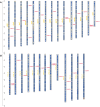Genome-wide identification, characterization and expression analysis of the BMP family associated with beak-like teeth in Oplegnathus
- PMID: 35923711
- PMCID: PMC9342863
- DOI: 10.3389/fgene.2022.938473
Genome-wide identification, characterization and expression analysis of the BMP family associated with beak-like teeth in Oplegnathus
Abstract
Bone morphogenetic proteins (BMPs), which belong to the transforming growth factor beta (TGF-β) family, are critical for the control of developmental processes such as dorsal-ventral axis formation, somite and tooth formation, skeletal development, and limb formation. Despite Oplegnathus having typical healing beak-like teeth and tooth development showing a trend from discrete to healing, the potential role of BMPs in the development of the beak-like teeth is incompletely understood. In the present study, 19 and 16 BMP genes were found in O. fasciatus and O. punctatus, respectively, and divided into the BMP2/4/16, BMP5/6/7/8, BMP9/10, BMP12/13/14, BMP3/15 and BMP11 subfamilies. Similar TGFb and TGF_β gene domains and conserved protein motifs were found in the same subfamily; furthermore, two common tandem repeat genes (BMP9 and BMP3a-1) were identified in both Oplegnathus fasciatus and Oplegnathus punctatus. Selection pressure analysis revealed 13 amino acid sites in the transmembrane region of BMP3, BMP7, and BMP9 proteins of O. fasciatus and O. punctatus, which may be related to the diversity and functional differentiation of genes within the BMP family. The qPCR-based developmental/temporal expression patterns of BMPs showed a trend of high expression at 30 days past hatching (dph), which exactly corresponds to the ossification period of the bones and beak-like teeth in Oplegnathus. Tissue-specific expression was found for the BMP4 gene, which was upregulated in the epithelial and mesenchymal tissues of the beak-like teeth, suggesting that it also plays a regulatory role in the development of the beak-like teeth in O. punctatus. Our investigation not only provides a scientific basis for comprehensively understanding the BMP gene family but also helps screen the key genes responsible for beak-like tooth healing in O. punctatus and sheds light on the developmental regulatory mechanism.
Keywords: BMP; Oplegnathus fasciatus; Oplegnathus punctatus; adaptive evolution; gene expression; gene family; tooth development.
Copyright © 2022 Ma, Xiao, Xiao, Wu, Zhao, Gao, Wu, Wang, Zhao and Li.
Conflict of interest statement
Author ZX was employed by the company Weihai Haohuigan Marine Biotechnology Co. The remaining authors declare that the research was conducted in the absence of any commercial or financial relationships that could be construed as a potential conflict of interest.
Figures










Similar articles
-
Morphological characteristics of beak-like tooth in spotted knifejaw (Oplegnathus punctatus) and mechanisms of dental development regulation by the Wnt, BMP, FGF and SHH signalling pathways.Int J Biol Macromol. 2023 Oct 1;250:126188. doi: 10.1016/j.ijbiomac.2023.126188. Epub 2023 Aug 9. Int J Biol Macromol. 2023. PMID: 37562479
-
In Silico Analysis: Genome-Wide Identification, Characterization and Evolutionary Adaptations of Bone Morphogenetic Protein (BMP) Gene Family in Homo sapiens.Mol Biotechnol. 2024 Nov;66(11):3336-3356. doi: 10.1007/s12033-023-00944-3. Epub 2023 Nov 1. Mol Biotechnol. 2024. PMID: 37914865
-
Bone morphogenetic proteins.Growth Factors. 2004 Dec;22(4):233-41. doi: 10.1080/08977190412331279890. Growth Factors. 2004. PMID: 15621726 Review.
-
Genome-Wide Scan Reveals Toll-Like Receptor Contraction Events in Oplegnathidae.DNA Cell Biol. 2022 Oct;41(10):879-892. doi: 10.1089/dna.2022.0234. Epub 2022 Sep 14. DNA Cell Biol. 2022. PMID: 36108301
-
BMP3: to be or not to be a BMP.J Bone Joint Surg Am. 2001;83-A Suppl 1(Pt 1):S56-62. J Bone Joint Surg Am. 2001. PMID: 11263666 Review.
Cited by
-
Identification and expression profiling of the bone morphogenetic protein gene family based on pearl culture in mantle and visceral mass of Hyriopsis cumingii.Front Vet Sci. 2024 Aug 21;11:1445594. doi: 10.3389/fvets.2024.1445594. eCollection 2024. Front Vet Sci. 2024. PMID: 39234175 Free PMC article.
-
Developing a genome-wide long sequence-specific tag for sex identification in spotted knifejaw (Oplegnathus punctatus).Mol Genet Genomics. 2025 Mar 19;300(1):32. doi: 10.1007/s00438-025-02240-y. Mol Genet Genomics. 2025. PMID: 40106105
References
LinkOut - more resources
Full Text Sources
Miscellaneous

